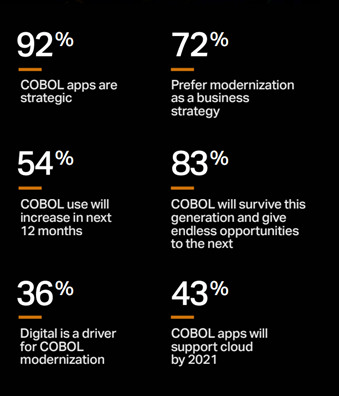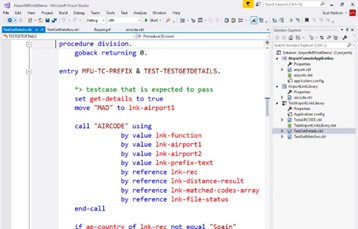Secure New Skills with Modern COBOL
COBOL isn’t seen as a modern development technology. Now over six decades old, it’s viewed as an important technology of the past, but not necessarily something to use today and into the future. Recent research, however, might surprise you. Renowned research firm, Vanson Bourne, uncovered that COBOL is very pervasive across the IT industry. Over 800 billion lines of code exist today. They support everyday uses cases including ATMs, online banking, buying and selling equities, booking your airline ticket, hotel or rental car reservation, auto service, and more. Quietly powering most of our modern economy, COBOL is truly everywhere. With that much code in active use, the question becomes, ”Where do we go from here?”

Chasing the new
With this much COBOL code in use, one would think there would be ample developers to support current and future IT needs. Think again. In an industry where technology is constantly changing at lightspeed, the perception is that yesterday’s tools are old and outdated and then discarded for the new—that often unproven and shiny object. We see this behavior play out across the technology sector, from smartphones, to home electronics and beyond. Consumers race to replace their current device with the latest and greatest. Enterprise IT has a similar mindset. Executives race to remove COBOL and other well established systems and replace it with new technology, hoping this move enables digital transformation, improves IT agility, and also attracts future talent to support these IT systems. But is there a better way?
Continuous modernization
IT project success and failure has been a topic often studied by many, but perhaps none as well renowned as The Standish Group. With over 50,000 IT projects analyzed over 25 years, one could argue they are the leading authority on this topic. In their recent report, Standish reveals that organizations who pursue a continuous modernization (also known as flow) approach have a 71% chance of overall project success as compared to just 1% when pursuing other strategies. Those numbers are compelling and for those invested in COBOL systems, the message of modernization has significant value. But is modern tech capable of transforming yesterday’s COBOL into a digital-age solutions—ready for APIs, DevOps, containers, and cloud?
Modern COBOL
There have been numerous advancements to COBOL technology since 1959. Aside from the many language advancements, COBOL has arguably become the most portable tech in the industry supporting a wide range of platforms across distributed, mainframe, virtual and cloud environments. One of the most significant advancements to COBOL is its integration within modern development tools such as Visual Studio, Eclipse and now Visual Studio Code. Today’s developers have a powerful, yet familiar, environment to build, manage and modernize existing COBOL applications. In fact, some of the latest releases of modern COBOL unveil new modernization tools for COBOL code refactoring, code slicing, API enablement as well as integration with Docker containers and Kubernetes. You can now take a COBOL program written over 30 years ago and integrate it with today’s technology—in many cases without changing the code. That’s powerful technology and the tools IT shops need to transform business applications. Can this new tech also help bridge the COBOL skills gap?
New tech, new skills
Building new skills doesn’t necessarily require a new IT stack, but rather a new mindset. Recent technology advancements have made older languages, such as COBOL, just as modern as C# or Java. Modern COBOL breaks down the learning barrier through its native integration with popular industry standard IDEs such as VSCode, Eclipse or Visual Studio. COBOL becomes a first-class citizen and language within these modern environments—enabling the developer to tackle the rewarding world of COBOL modernization with ease and confidence. As exciting as this may appear, this isn’t new news. These modern advancements have been available for over 10 years and proven through thousands of end user deployments. From a technology standpoint, Modern COBOL is ready to help you take on your skills concerns with the confidence and reliability needed for enterprise IT.
Developers, start your IDE
One of the best approaches to tackling the skills gap is through education. By that I mean opening the eyes of software developers, architects, engineers, and programmers to what’s truly possible. Modern COBOL is that educator. And for those considering learning COBOL, it’s easy to start.

Plan your path
Preparing for the future requires constant planning as well as review and revision of that plan. It’s an evolution. Securing future COBOL skills to support core business applications requires the same care, attention, and strategy. The good news is that modern technology can enable that process and make it much easier to attract and build new skills—whether you’re targeting new joiners or seasoned developers. There are also ample developer resources available to help you and your teams get started quickly. If you’re not quite ready for to dive in, join an online COBOL community and hear how your peers are building COBOL talent for tomorrow. Most importantly, start building your future skills plan and ensure that plan aligns to the goals and needs of your core business applications.
Related posts
Beyond Source Control: Verifying IBM i Bill of Materials for DevSecOps [...]
AI & Hybrid Cloud
Unlock the full potential of your business-critical applications and data with Rocket Software’s AI-driven solutions.
New Era of Mainframe Modernization with IBM z17
Mainframes are not just alive—they’re thriving.